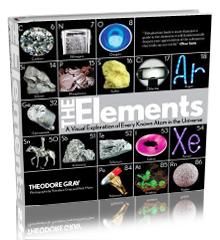Crowbar. | |||
| Sample Image | |||
| Crowbar. Why would anyone want a titanium crowbar? In my case because we have a projector screen with a handle that's hard to reach. It's located near the periodic table, and the only logical place to put something to hook the handle with is on my element shelf, but I don't allow anything on my element shelf that isn't an element sample. I didn't see any alternative really. Why anyone else would want a titanium crowbar is less clear. It is very light, which I suppose might be nice, but then again, often you really want some weight behind your crowbar, when you're jamming it in or under something. I suppose it's nice that it will never rust, but I haven't really had that problem with my half dozen other crowbars. My big problem with a titanium crowbar is that I'd be afraid to use it for fear of scratching the silky smooth finish. I wonder how they can be made so cheaply, considering how expensive other things made of titanium are. My understanding is that the price of titanium has dropped dramatically over the last few years because of the opening up of supplies from the former Soviet union, and the development of a new, cheaper process for refining it. The bar is genuine: Analysis by x-ray fluorescence spectroscopy at the Center for Microanalysis of Materials, University of Illinois (partially supported by the U.S. Department of Energy under grant DEFG02-91-ER45439) indicates that it is at least 98% titanium (possibly more, I wasn't being careful with the analysis). Not only that, after seeing the above, reader Michael Schultz wrote to inform me that there is a good use for titanium crowbars. Read on: I read through your page covering Titanium. You'd mentioned that you were unsure why anyone would want a titanium crowbar, however there actually is a market for such an item, although the market is a bit obscure. Titanium crowbars are often used by SCUBA divers for wreck diving or salvage. The reason a crowbar would be needed is obvious, and like you said, a titanium crowbar won't rust. However, more important than its resistance to rust, is its density.I stand corrected. And now, double-corrected. Reader Bob Shipp wrote in to add this additional application for a light crowbar: When rock climbers lay out new routes up cliffs there will often be rocks and handholds (sometimes relatively large, i.e. perhaps a hundred pounds or so) which are not securely attached. These rocks pose a real danger for climbers. If you find yourself hanging from one of these guys and it suddenly shifts or lets go, not only is the climber in danger - a moving rock may damage a rope easily - but especially those on the ground may be hurt. The more vertical the surface is the more danger these rocks may pose, and if you are climbing a roof, i.e. a severely overhanging climb, these rocks may peel off at any time. Just hope that you are not anchored in to it when it goes!Any more applications out there? Why yes, just a few weeks later, reader Jeff Jennings sent in this: I wonder if their magnets were anything like the supermagnets for sale here. Those three-inchers look pretty scary! Source: Dutchguard Contributor: Theodore Gray Acquired: 22 February, 2003 Text Updated: 11 August, 2007 Price: $40 Size: 22" Purity: >98% | |||
|

